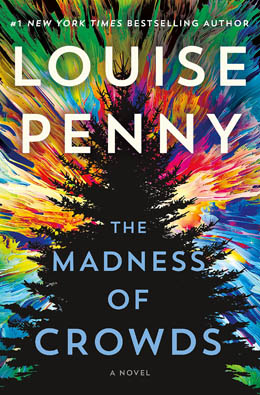Last year, Louise Penny took her legion of fans off to Paris with Armand Gamache and his family in the well-received All the Devils Are Here. As refreshing as it was to see these familiar characters in a new setting, loyal fans will be thrilled to know that Penny’s new novel, The Madness of Crowds, returns the action to Three Pines, with all its popular residents in tow. Featuring Louise Penny’s incredible ability to home in on the psychology of what makes humans tick and her fearlessness in tackling controversial topics, The Madness of Crowds will be a welcome addition to the Chief Inspector Gamache series for her many, many fans.
Like all authors, Louise Penny faced the challenge of how to incorporate the world-wide pandemic into her work – especially challenging for a series and while not knowing exactly what our “new normal” would look like post-Covid. The Madness of Crowds gets much of this correct, while not taking into account the devastating impact of variants. Because of the isolation of Three Pines, it is easy to believe that Penny’s version of “after” is possible, even if only for the short time period in which the novel takes place.
The Madness of Crowds is set around the winter holidays and while many people are relaxing and getting ready to celebrate Christmas, Gamache and his team are hired to work security for an upcoming lecture at a local University. It seems that Abigail Robinson will be speaking at the event and her unconventional views coming out of the pandemic have been causing a stir in the academic community.
Louise Penny does a nice job of creating a slow and steady build to the start of this lecture, with an air of mystery and trepidation surrounding the speech’s topic. There is enough evidence for concern which only increases the foreboding the reader feels as the pages turn. This is a crime novel, so of course, things do not go quite as planned at the event and tensions in the small village are high.
Many authors would be content with this level of unease, but Louise Penny ups the ante by weaving in an unexpected murder which may or may not be connected to the events at the public lecture. With no shortage of suspects, readers will speed through the chapters – many with cliffhanger endings – trying to sort the red herrings from the actual clues that will expose this murderer.
Each of the regular Three Pines citizens make appearances and their reactions to Gamache’s investigation vary. Louise Penny also brings to the canvas a number of new characters, among them, the chancellor at the University and Haniya Daoud, a Sudanese folk hero – both of whom are highly opinionated, controversial, and vocal in their convictions.
As with most of her novels, Louise Penny weaves in obscure, but true, information she has discovered over the years. In this case, an unusual anthropological theory is mentioned and echoes throughout the remainder of the investigation. It is tidbits like this that readers will carry with them into life – one of the many reasons fans of Louise Penny enjoy getting together to discuss her novels in depth.
Every review of Louise Penny’s oeuvre that I have written talks about her innate ability to understand human nature – both the good and the bad, but also the grey in between. With The Madness of Crowds, she is one of the first crime fiction authors to tackle the pandemic and its aftermath head-on and in doing so becomes almost a literary Oracle at Delphi, mapping out both the rewards and the pitfalls facing society after such an unprecedented and seismic pandemic.
In the end, The Madness of Crowds stands as one of the best novels in Louise Penny’s excellent, and now iconic, series. The ramifications of events from this novel will still be felt moving forward and fans will be clamoring to find out what will happen next.

BUY LINKS: The Madness of Crowds by Louise Penny
Disclaimer: An e-galley of this title was provided to BOLO Books by the author. No promotion was promised and the above is an unbiased review of the novel.
